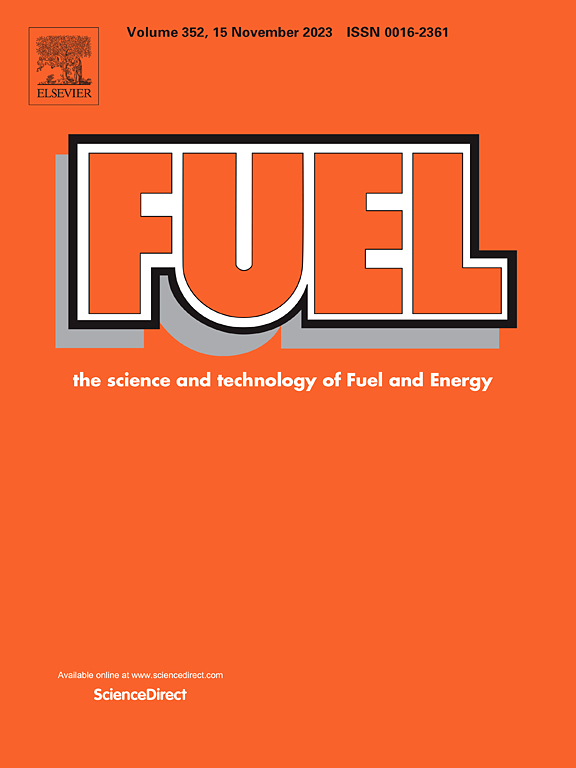热局部改造在降低沥青运输稀释剂用量方面的应用前景广阔
IF 6.7
1区 工程技术
Q2 ENERGY & FUELS
引用次数: 0
摘要
稀释剂添加和部分升级是两种不同的技术,旨在降低沥青的粘度和提高其运输到炼油厂的能力。然而,每种方法都有其局限性。克服这些挑战的实际解决方案是将热部分升级与稀释剂添加相结合,这也是本研究的主要目标。研究的第一步是在420°C的温度下对沥青进行部分热升级,在目标温度下没有停留时间。在21°C下,该工艺显著地将沥青粘度从169,000 cSt降至752 cSt,最小的焦炭生成率仅为0.03 wt%,产气量为2.16 wt%。对沥青和升级油成分的分析表明,在升级过程中,沥青中约20%的真空渣油馏分转化为轻馏馏分。总酸数(TAN)由2.5 mg KOH/g降至1.09 mg KOH/g。沥青质含量降低了约3%,氮和硫含量分别降低了约35%和15%。然而,升级后的油中的烯烃含量(1.89 wt%)略高于管道运输允许的极限(1.0 wt%)。在接下来的步骤中,将稀释剂添加到部分升级的油中以满足粘度要求,并量化原料沥青所需的溶剂。热部分升级将稀释剂的需求从大约33 vol%减少到9 vol%。最后,提出了酸催化水合反应作为降低烯烃含量的一种潜在技术,以解决高烯烃含量的问题。由于热裂解产生的烯烃倾向于在低沸点馏分中积累,如石脑油(沸点≤175℃),因此对热部分升级过程中获得的石脑油样品进行了酸催化水化试验。本研究提出的方法有望通过在目标温度下不停留时间来提高沥青处理能力,同时减少对稀释剂的需求。本文章由计算机程序翻译,如有差异,请以英文原文为准。

Promising prospects of thermal partial upgrading in reducing diluent requirements for bitumen transportation
Diluent addition and partial upgrading are two distinct techniques aimed at reducing the viscosity of bitumen and enhancing its transportability to refineries. Nevertheless, each method has its own limitations. A practical solution to overcome these challenges, which constitutes the primary objective of this research, is to integrate thermal partial upgrading with diluent addition. The first step of the study entailed thermal partial upgrading of bitumen at 420 °C with no residence time at target temperature. The process notably reduced bitumen viscosity from 169,000 cSt to 752 cSt at 21 °C with minimal coke formation of only 0.03 wt% and gas production of 2.16 wt%. Analysis of the bitumen and upgraded oil compositions revealed that around 20 % of the vacuum residue fraction in the bitumen was converted into the light cut fraction during the upgrading process. Additionally, the total acid number (TAN) decreased from 2.5 to 1.09 mg KOH/g. Asphaltene contents decreased by approximately 3 %, while nitrogen and sulfur contents reduced by around 35 % and 15 %, respectively. However, the olefin content in the upgraded oil (1.89 wt%) slightly exceeded the limit allowed for pipeline transportation (1.0 wt%). In the subsequent step, diluent was added to the partially upgraded oil to meet the viscosity requirements, and the solvent needed for feed bitumen was quantified. The thermal partial upgrading reduced the need for diluent from approximately 33 vol% to 9 vol%. Eventually, acid-catalyzed hydration was suggested as a potential technique for reducing the olefin levels to address the issue of high olefin content. As olefins generated through thermal cracking tend to accumulate in lower boiling fractions such as naphtha (boiling point ≤ 175 °C), acid-catalyzed hydration was examined on a naphtha sample obtained from a thermal partial upgrading process. The proposed approach in this study holds promise for enhancing bitumen processing capacity through no residence time at target temperature while diminishing the need for diluent.
求助全文
通过发布文献求助,成功后即可免费获取论文全文。
去求助
来源期刊

Fuel
工程技术-工程:化工
CiteScore
12.80
自引率
20.30%
发文量
3506
审稿时长
64 days
期刊介绍:
The exploration of energy sources remains a critical matter of study. For the past nine decades, fuel has consistently held the forefront in primary research efforts within the field of energy science. This area of investigation encompasses a wide range of subjects, with a particular emphasis on emerging concerns like environmental factors and pollution.
 求助内容:
求助内容: 应助结果提醒方式:
应助结果提醒方式:


